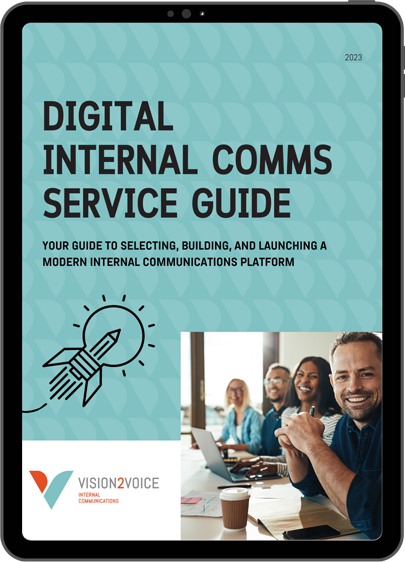Chief Communications Officer: The seven things your CEO’s internal communications strategy needs

The most important role a CEO has in every organization is that of Chief Communicator. Why? Because the CEO needs to do two things:
- She must mobilize people around a common goal. If you think of some of the great leaders of our time and some of humankind’s most amazing accomplishments (putting a person on the moon), the leaders behind those great achievements all had the incredible ability to unite people around a common goal.
- She must bring out the best in others. These leaders use their communication skills to help people learn, grow and thrive. I like Harvard Professors Frances Frei and Anne Morris’s definition of leadership (found in their book, Unleashed: The Unapologetic Leader’s Guide to Empowering Everyone Around You):
“Leadership is about empowering other people as a result of your presence – and making sure that impact continues into your absence.”
What Many Leaders are Missing
Both of these leadership roles require the ability to communicate effectively and strategically. To do this leaders need the ability to deliver information that is meaningful and makes people THINK, FEEL, and ACT a certain way. They also need to develop listening skills so employees feel safe to speak up, raise concerns, ask questions, and bring new ideas to the table.
Now, show me a CEO who is a trained communicator.
Find one yet?
Of course not! And this (as most communicators know too well) is the problem, which manifests itself in a number of ways:
- No active and visible leadership
- Tone-deaf communication that is not in touch with what employees want and need
- Communication that is stiff, sanitized, and vague or is so unvarnished that it doesn’t resonate or doesn’t have a point
- Employees who don’t understand where the organization is going or why decisions are being made
- A culture of exhaustion, fear, and stress
- People who feel stifled and disconnected
Seven steps to a strategy your CEO will get behind
We’ve worked with a few organizations over the past year where the main focus was helping leaders at the very top become better communicators. It hasn’t been easy. In the midst of these projects, leaders have had to navigate a global pandemic, they faced reckoning on the diversity and inclusion front, and our American clients have had to deal with the divisiveness of a presidential election and the chaos that ensued.
Let’s talk about how to help the CEO (and the most senior leaders in your organization) communicate effectively. The place to start is by developing an Executive Communications Strategy that helps leaders at the most senior levels of the organization communicate with clarity and impact. The executive communications strategy should do six things:
Start with the right goals. I start with the kind of goals a CEO can get behind, including supporting a strong brand, culture, and employee experience. By aligning your communication goals with the kind of culture, brand, and employee experience your organization is building, it becomes clear to leaders how your internal communication strategy will drive the outcomes that are needed for your organization to succeed.
Build understanding. Leadership is not about the leader; it is about employees. This is why it is important to help leaders better understand what matters to their people. Building personas is the perfect way to capture and convey what makes people in your organization tick and what motivates them.
Establish guidelines. Many internal communications professionals end up in a battle over content, wording, or even grammar. Too authentic, not authentic enough, too stiff, tone-deaf, sanitized, or unclear. The best way I’ve found to help a CEO understand why certain communication principles are important is to educate them. Share data, an article from a credible source, or science that reinforces your professional expertise. It goes a long way.
Build a strategic narrative. A strategic narrative sounds fancy but it’s really not. The difference between communication and strategic communications is that communicating strategically means you are always reinforcing important messages with your communication. To be honest, I really don’t like calling them messages because that makes it sound shallow but your content always needs to link back to your organization’s purpose and the behaviours and values that will support your culture.
Coach the CEO to listen just as much as they talk. Leaders often think they need to have all of the answers or be the smartest in the room. That may have been the case 100 years ago but in today’s information age, leaders need to harness the collective intelligence of all of the smart people they worked so hard to recruit. When solving problems, navigating change, and innovating, asking the right questions, and listening to the people around you is a far more effective leadership strategy.
Encourage employees to share honest feedback. One of my first clients began his career as a politician before transitioning to the role of CEO of a large organization. He told me that as a politician, people tripped over themselves to provide him with their opinion on his performance but as CEO, it became difficult to find out how he was doing. He had to change people’s mindsets so that they would feel safe speaking up.
Manage and track. Work with the CEO to agree on how outcomes will be measured. Get support and commitment to tracking, managing, and conducting frequent retrospectives to build continuous learning and improvement into the CEO’s internal communication strategy. Sometimes this even means making sure key questions are included in people surveys or that internal communication technology platforms are implemented to enable pulse surveys and real-time metrics.
About six months ago, we developed an executive communication strategy for a CEO. He was new and wanted to transform the organization at a critical time. We developed a strategy to support the kind of culture that the organization’s business goals would be achieved. We always ask for feedback after a project is over and what the client said had us jumping for joy. The strategy had opened the CEO’s eyes to the value of internal communication and he had gained a new appreciation for the difference it could make.
A word about tactics
Once leaders have had a chance to review and approve the strategy, then it’s time to develop a tactical plan – i.e., the specific tasks or activities that will support your strategies’ goals. Avoid the temptation to start with tactics at all costs!!!! You first need to get an agreement on where you are going (the strategy) before you decide how to get there. What’s worked particularly well for my clients is finding the channels and activities that naturally suit the leader’s ability and personality. It has to be authentic. Yes, you can push them out of their comfort zone, but don’t push a tactic or activity on a CEO just because some other CEO did it or it’s trending. For example, certain activities are better for a leader who is an introvert, smaller group settings, interview-style videos or podcasts might be better than large events.
If you’re looking for further guidance on how to develop an Executive Communications Strategy, send us a message!





